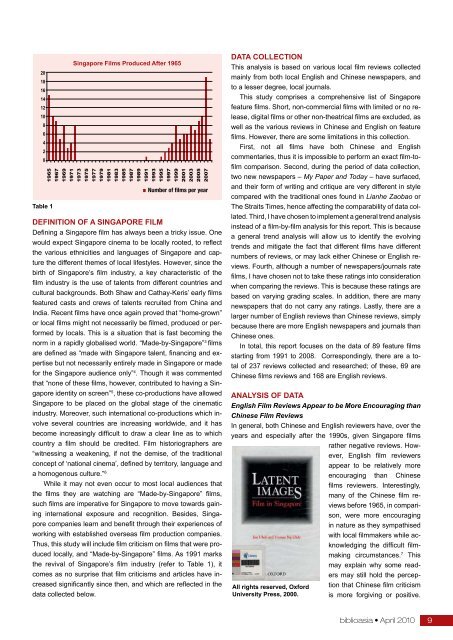BiblioAsia - National Library Singapore
BiblioAsia - National Library Singapore
BiblioAsia - National Library Singapore
- No tags were found...
Create successful ePaper yourself
Turn your PDF publications into a flip-book with our unique Google optimized e-Paper software.
Table 1<strong>Singapore</strong> Films Produced After 19651965196719691971197319751977197919811983198519871989199119931995199719992001200320052007Number of films per yearDEFINITION OF A SINGAPORE FILMDefining a <strong>Singapore</strong> film has always been a tricky issue. Onewould expect <strong>Singapore</strong> cinema to be locally rooted, to reflectthe various ethnicities and languages of <strong>Singapore</strong> and capturethe different themes of local lifestyles. However, since thebirth of <strong>Singapore</strong>’s film industry, a key characteristic of thefilm industry is the use of talents from different countries andcultural backgrounds. Both Shaw and Cathay-Keris’ early filmsfeatured casts and crews of talents recruited from China andIndia. Recent films have once again proved that “home-grown”or local films might not necessarily be filmed, produced or performedby locals. This is a situation that is fast becoming thenorm in a rapidly globalised world. “Made-by-<strong>Singapore</strong>” 3 filmsare defined as “made with <strong>Singapore</strong> talent, financing and expertisebut not necessarily entirely made in <strong>Singapore</strong> or madefor the <strong>Singapore</strong> audience only” 4 . Though it was commentedthat “none of these films, however, contributed to having a <strong>Singapore</strong>identity on screen” 5 , these co-productions have allowed<strong>Singapore</strong> to be placed on the global stage of the cinematicindustry. Moreover, such international co-productions which involveseveral countries are increasing worldwide, and it hasbecome increasingly difficult to draw a clear line as to whichcountry a film should be credited. Film historiographers are“witnessing a weakening, if not the demise, of the traditionalconcept of ‘national cinema’, defined by territory, language anda homogenous culture.” 6While it may not even occur to most local audiences thatthe films they are watching are “Made-by-<strong>Singapore</strong>” films,such films are imperative for <strong>Singapore</strong> to move towards gaininginternational exposure and recognition. Besides, <strong>Singapore</strong>companies learn and benefit through their experiences ofworking with established overseas film production companies.Thus, this study will include film criticism on films that were producedlocally, and “Made-by-<strong>Singapore</strong>” films. As 1991 marksthe revival of <strong>Singapore</strong>’s film industry (refer to Table 1), itcomes as no surprise that film criticisms and articles have increasedsignificantly since then, and which are reflected in thedata collected below.DATA COLLECTIONThis analysis is based on various local film reviews collectedmainly from both local English and Chinese newspapers, andto a lesser degree, local journals.This study comprises a comprehensive list of <strong>Singapore</strong>feature films. Short, non-commercial films with limited or no release,digital films or other non-theatrical films are excluded, aswell as the various reviews in Chinese and English on featurefilms. However, there are some limitations in this collection.First, not all films have both Chinese and Englishcommentaries, thus it is impossible to perform an exact film-tofilmcomparison. Second, during the period of data collection,two new newspapers – My Paper and Today – have surfaced,and their form of writing and critique are very different in stylecompared with the traditional ones found in Lianhe Zaobao orThe Straits Times, hence affecting the comparability of data collated.Third, I have chosen to implement a general trend analysisinstead of a film-by-film analysis for this report. This is becausea general trend analysis will allow us to identify the evolvingtrends and mitigate the fact that different films have differentnumbers of reviews, or may lack either Chinese or English reviews.Fourth, although a number of newspapers/journals ratefilms, I have chosen not to take these ratings into considerationwhen comparing the reviews. This is because these ratings arebased on varying grading scales. In addition, there are manynewspapers that do not carry any ratings. Lastly, there are alarger number of English reviews than Chinese reviews, simplybecause there are more English newspapers and journals thanChinese ones.In total, this report focuses on the data of 89 feature filmsstarting from 1991 to 2008. Correspondingly, there are a totalof 237 reviews collected and researched; of these, 69 areChinese films reviews and 168 are English reviews.All rights reserved, OxfordUniversity Press, 2000.ANALYSIS OF DATAEnglish Film Reviews Appear to be More Encouraging thanChinese Film ReviewsIn general, both Chinese and English reviewers have, over theyears and especially after the 1990s, given <strong>Singapore</strong> filmsrather negative reviews. However,English film reviewersappear to be relatively moreencouraging than Chinesefilms reviewers. Interestingly,many of the Chinese film reviewsbefore 1965, in comparison,were more encouragingin nature as they sympathisedwith local filmmakers while acknowledgingthe difficult filmmakingcircumstances. 7 Thismay explain why some readersmay still hold the perceptionthat Chinese film criticismis more forgiving or positive.biblioasia • April 20109

















